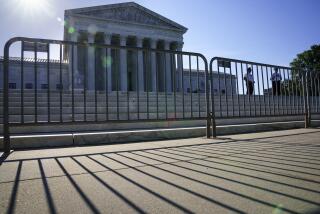A Real-Life High Court
- Share via
As he approaches his second term, President Bush seems almost certain to have the opportunity to fill one or more vacancies on the U.S. Supreme Court. But as he begins to think about how to fill those jobs, history suggests that he should reject the recent trend toward elevating lower court judges and look instead for candidates from beyond the bench.
In 1953, when Dwight Eisenhower became the first Republican in a generation to occupy the White House, he inherited a court whose nine members had all been appointed by Democrats.
They were men of varied backgrounds, and their disputes were already legendary, but the great members of that court had one thing in common: Not one had been a judge before joining the Supreme Court.
Robert Jackson, one of the finest writers in the court’s history, had served as President Franklin D. Roosevelt’s attorney general before joining the brethren.
Hugo Black, who went on to become the 1st Amendment’s great absolutist champion, was a senator from Alabama (early in his career, Black briefly served as a night police court judge, but by the time of his appointment that was long past, and his national reputation was the result of his Senate service).
Restless, irascible, brilliant William O. Douglas headed the Securities and Exchange Commission at the height of the New Deal before joining the court at age 40.
And Felix Frankfurter, whose belief in judicial restraint would place him at odds with Black and Douglas for much of their careers, came to the court from Harvard Law School, from which he had advised FDR and tutored a generation of liberal lawyers.
Those four great justices -- among the most important of the 20th century -- all occupied places on the bench when Chief Justice Fred Vinson died suddenly and gave Eisenhower his first vacancy.
Eisenhower (a genuine moderate, in contrast to Bush, for whom political moderation is more a campaign device than a true value) no doubt approached the vacancy differently than Bush will if one occurs. But it is an opportunity to leave a lasting imprint on the only branch of government whose members serve for life.
This time around, it also represents an overdue opportunity to inject some of the outside world into a cloistered body.
In contrast to the varied bench that FDR and President Truman built, today’s court is drawn almost entirely from the bench. Six of its seven Republicans and both of its Democrats were chosen for the high court from state and federal courts, and they have been together for more than a decade.
In addition, although some of them brought earlier life experiences to those posts, their distinction came from their experiences as judges, not from other fields.
Only one, Chief Justice William Rehnquist, came directly to the court from a nonjudicial position, and he did so more than 30 years ago (Rehnquist was a deputy attorney general in the Nixon administration before moving to the court in 1972).
That singularity of background deprives the court of energy and experience. It mattered to the court during its tumultuous desegregation days that Black grew up in Alabama and served as the state’s senator; he understood its people and helped his brethren to do so as well.
It was important in evaluating the federal government’s role in the economy of the 1940s to have Douglas, with his SEC background, among those who weighed the issues.
And it broadened the court to draw upon Frankfurter, one of the nation’s most esteemed law professors, and Jackson, who built a small-town practice around working people as well as banks and railroads and whose skill as a practicing lawyer made him one of the finest advocates in American history.
Why have recent presidents been inclined to limit their search for justices to those already on the bench? For one thing, it makes confirmation easier, and for another, it helps avoid unpleasant surprises from justices who receive a lifetime appointment and then rule differently than the presidents who appointed them expected.
In 1953, recognizing the value of extrajudicial experience -- and faced with a judiciary largely populated by Democrats -- Eisenhower bypassed a few qualified Republican judges and instead reached into politics to select California Gov. Earl Warren as the 14th chief justice of the United States. Until taking the oath on Oct. 4, 1953, Warren had never spent a day on the bench.
Though Warren’s record remains controversial -- and though Eisenhower disagreed with much of what the Warren court did -- the experience Warren brought to the office from his years as a politician helped fashion a more engaged court, marked by its determination to deliver individual justice and its willingness, even its eagerness, to tackle the country’s most pressing political and social concerns.
His appointment made Eisenhower inadvertently responsible for much of the nation’s contemporary social change -- for integrating schools and public facilities, broadening free speech, giving urban voters more voting significance and establishing a constitutional right to privacy. It was a legacy that sometimes made Eisenhower uncomfortable, but it rejuvenated the court and helped enlarge human liberty in the United States. It should stand as a lesson for Bush.
More to Read
Get the L.A. Times Politics newsletter
Deeply reported insights into legislation, politics and policy from Sacramento, Washington and beyond. In your inbox twice per week.
You may occasionally receive promotional content from the Los Angeles Times.











